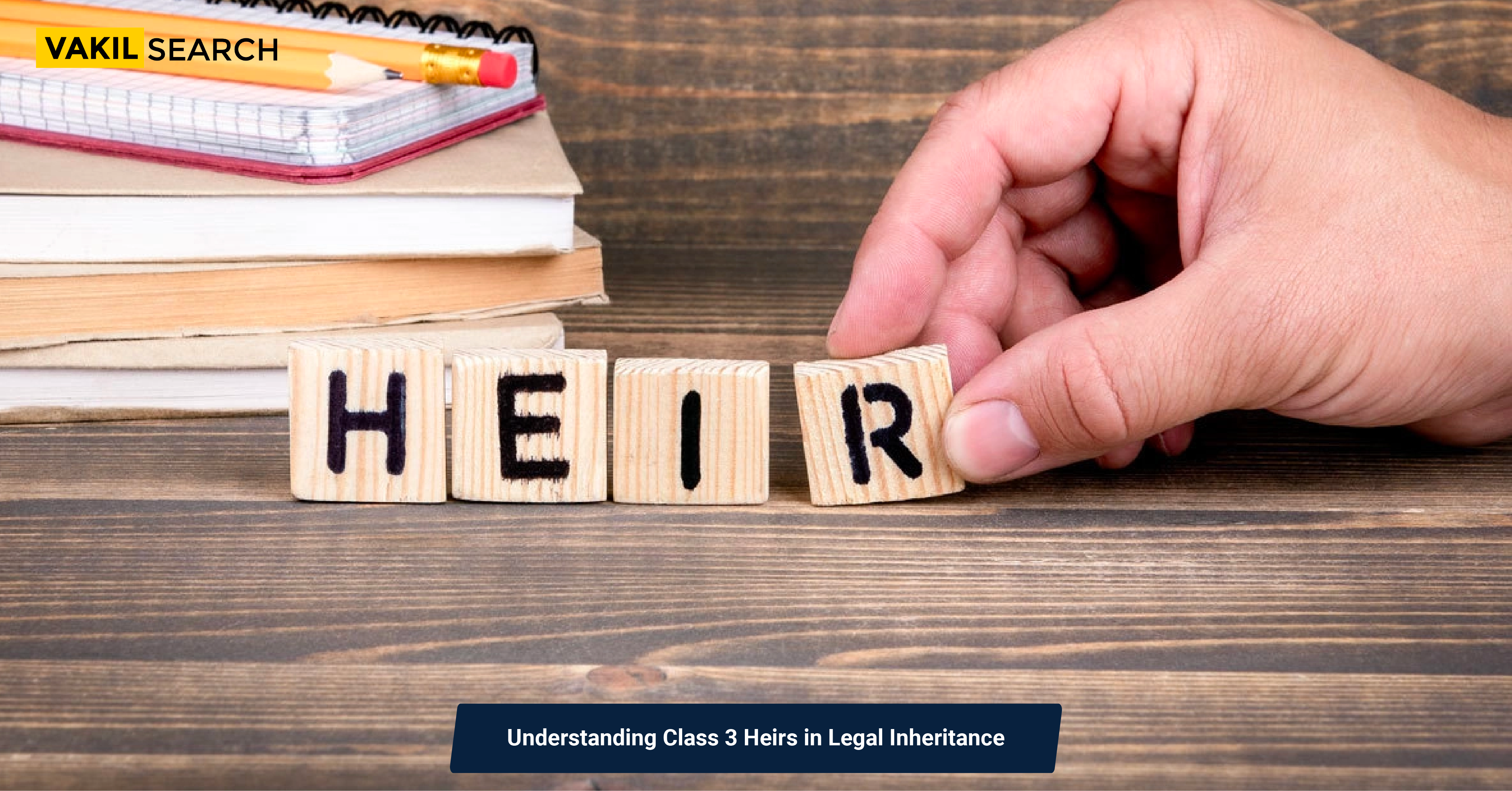Jump into the world of Class 3 heirs under the Hindu Succession Act. This comprehensive guide explains everything you need to know.
Latest Update:
On January 31st, 2022, the Supreme Court directed that a petition challenging Section 15 of the Hindu Succession Act, 1956, be listed before a three-judge Bench. In this blog Understand Class 3 Heirs in Legal Inheritance.
The petitioner argued that Section 15 of the Hindu Succession Act discriminates against women, violating Article 15 of the Constitution of India, 1950.
The case reached the Supreme Court through a Special Leave Petition filed in December 2018 against a Bombay High Court Order. Along with the Special Leave Petition, a Writ Petition challenging the constitutionality of Section 15 of the Hindu Succession Act was also filed at the Supreme Court.
The Bombay High Court Order stated that a woman did not have a claim to the property of her deceased daughter during the lifetime of her daughter’s spouse. The dispute between the woman and her daughter’s spouse was eventually settled through a settlement, leading to the dismissal of the Special Leave Petition by the Supreme Court. However, the Court decided to hear the Writ Petition as it raised issues related to gender equality.
Section 15(1) of the Hindu Succession Act stipulates that the property of a Hindu woman who dies without a will (intestate) shall be inherited by her sons, daughters, and husband. If the woman has no living husband or children, the property shall devolve on the heirs of the husband. Only if the woman’s husband has no heirs shall the property be inherited by the woman’s parents.
In contrast to Section 15(1), Section 8 outlines how the property of a Hindu man who dies intestate is to devolve. For a Hindu man who has died intestate, the property shall devolve on the heirs specified in Class I of the Schedule to the Hindu Succession Act.
Class I heirs include the wife, children, and mother of the Hindu male, along with certain other relatives, including specific grandchildren. If there are no living Class I heirs, the property shall devolve on Class II heirs.
Class II heirs include the man’s father and other relatives, including certain grandchildren. If there are no Class I or II heirs, the property shall devolve on agnates, who are persons related to the Hindu man wholly through male relations, either by blood or adoption.
In the event that there are no Class I or Class II heirs or agnates, the property shall devolve on cognates, who are persons not wholly related through male relations, either by blood or adoption.
There is a difference between the inheritance schemes laid out in Sections 15 (for Hindu women) and 8 (for Hindu men) of the Act. Under Section 15, the intestate woman’s husband and his heirs are prioritized over the woman’s parents. In contrast, for an intestate man under Section 8, the man’s parents are Class I and Class II heirs, and there is no mention of the wife’s heirs inheriting their property.
Pointing to this difference, the petitioners have challenged Section 15 of the Act for being discriminatory and for creating different inheritance schemes for intestate men and women.
Introduction
In India, the Hindu law of inheritance is governed by the Hindu Succession Act, which divides heirs into different classes based on their proximity to the deceased. Class 1 heirs are the closest relatives and have the first right to inherit the property of a deceased Hindu male. If there are no Class 1 heirs, the property devolves to Class 2 heirs. If there are no Class 2 heirs, the property devolves to Class 3 heirs, also known as agnates. Followed by Class 4 heirs, also known as cognates.
In this article, we will discuss who qualifies as a Class 3 heir, how they fit into the legal heirship hierarchy, and why it’s important to know about them. We will also look at some landmark cases on agnates in India.
Who Are Class 3 Heirs?
Class 3 heirs, also known as ‘agnates,’ are individuals related to the deceased through male ancestry.
In simpler terms, In case a Hindu male passes away intestate and leaves no class 1 or class 2 heirs, then the property would devolve on agnates. A person is said to be an agnate of another if the two are related by blood or adoption wholly through males.
The agnate relationship does not extend to relationships forged by marriage and is restricted to relationships by blood. Also, Class 3 heirs do not include widows of lineal descendants of the intestate.
Class 3 Heir: Eligibility Criteria
For an individual to be considered a Class 3 heir, they must fulfil the following criteria:
Male Ancestry: They must be descendants of the deceased through the male lineage.
Blood Relation: They should be related to the deceased.
Not Governed by Class 1 or 2 Heir Rules: If an individual qualifies as a Class 1 or Class 2 heir (like a spouse or children), they will not be considered Class 3 heirs.
Legal Implications
The presence of Class 3 heirs can significantly impact the distribution of property among legal heirs. In cases where there are no Class 1 heirs or Class 2 heirs Class 3 heirs come into the picture.
Let’s consider an example:
If a deceased person leaves behind no Class 1 or Class 2 heirs, the Class 3 heirs become entitled to the entire property. If there are both Class 2 and Class 3 heirs, only Class 2 heirs can inherit.
Rules of Preference Applicable to Class 3 Heirs
Class 3 heirs are blood relatives of the deceased through the male line and can be direct ascendants or descendants. The following rules of preference are prescribed for Class 3 heirs:
- Where an agnate has both ascent and descent degrees, each has to be considered separately.
- An agnate having a descent degree will be preferred over the one having an ascent degree.
- When two agnates have ascent and descent degrees, the one having a lesser number of ascent degrees will be preferred.
How Do Class 3 Heirs Fit into the Legal Heirship Hierarchy?
Class 3 heirs are the third category of heirs in the Hindu law of succession. They inherit the property of a deceased Hindu male in the absence of Class 1 and Class 2 heirs.
Why Is It Important to Know About Class 3 Heirs?
Understanding the legal heirship hierarchy is crucial in determining who has the right to inherit the property of a deceased Hindu male, especially in cases where there is no will. It’s important to know about Class 3 heirs because they have the right to inherit the property of a deceased Hindu male in the absence of Class 1 and Class 2 heirs.
Conclusion
Understanding Class 3 heirs in legal inheritance is crucial in determining who has the right to inherit the property of a deceased Hindu male. Class 3 heirs are blood relatives of the deceased, and can be direct ascendants or descendants, male or female. They inherit the property of a deceased Hindu male in the absence of Class 1 and Class 2 heirs.
Frequently Asked Questions (FAQs)
What if there are disputes among Class 3 heirs?
Disputes can arise, and in such cases, legal proceedings may be necessary to determine the rightful distribution of assets.
Can Class 3 heirs be excluded from inheritance?
In the absence of Class 1 and Class 2 heirs, Class 3 heirs are entitled to a share in ancestral property by law. However, in some cases, the deceased may have specified otherwise in a valid will.
Can Class 3 heirs inherit if there are Class 1 or Class 2 heirs?
No, Class 3 heirs inherit only when there are no Class 1 or Class 2 heirs. If such heirs exist, they have a prior claim.
Are Class 3 heirs eligible to inherit in all religions in India?
Class 3 heirs' rights and eligibility are governed by the Hindu Succession Act, which applies uniformly across India to Hindus, Buddhists, Sikhs, and Jains.
Read more:-










